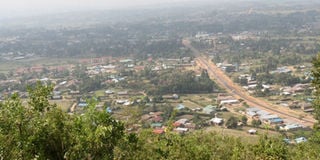How local dialects influenced naming of west Kenya towns

PHOTO | FILE A view of Webuye town from Chetambe Hills, which were named after a Tachoni warrior by the same name.
The naming of administrative towns and other settlements in the Luhya areas of Western Kenya bears deep roots to the local dialects. Most of them were sourced from the Abaluhya community, which is an amalgamation of about 18 tribes.
Luhya translates to ‘clan’ or ‘same hearth’, depending on the dialect. Abaluhya, thus, means ‘people of the clan’ or ‘those of the same hearth.’
Kakamega
Kakamega derives its modern name from the local dialect. The story goes that when European settlers first visited the area now known as Kakamega and were offered maize meal, the local staple food called Obusuma, they tried to emulate the eating style for which the tribe was famous. To the hosts though, the visitors were more like ‘pinching’ the Obusuma. The resulting administrative area was named ‘Kakamega’, which roughly translates to ‘pinch.’
Nonetheless, the local name for Kakamega was Sheywe. It is still used in informal talk in the area, but its source remains unclear.
Kakamega became the district headquarters in 1922 after the earlier administrative base in the area was moved from Mumias due to heat and malaria.
The Kakamega Gold Rush of 1931 cemented the name of the administrative area and its resulting fame. It also bred its own local names as more prospectors settled in the area in the hope of striking gold. ‘Ikolomani’ is a luhya corruption of ‘gold mine’, so called because of the presence of several mines in the area.
Mumias
The previous district headquarters before Kakamega, Mumias, was named after the famous paramount chief of the Wanga tribe, Nabongo Mumia. Mumias is more like the possessive form of Mumia, but without the apostrophe. The area was the seat of Mumia’s power as king and later as a paramount chief under British rule.
Bungoma
Another town, Bungoma, was named from engoma — the Bukusu word for drums. The town was originally a meeting place for Bukusu elders. The sound of drums would emanate from the area as the meeting venue, leading to its eventual naming as Bungoma.
There is a second version of the story. It says that in the early days, the area was occupied by the Bungomek, a clan of the Sabaot. The Bungomek was later driven out by the Bukusu, but the name Bungoma, in reference to their occupation, remained.
Webuye
One of Bungoma’s historical sites, the Chetambe Hills, overlook Webuye town. It is named after a Tachoni warrior Chetambe Ifile who fought the British in 1895.
In the pre-independence times, Webuye was known as Broderick Falls, after the first whiteman to visit the nearby Nabuyole falls on River Nzoia. Today, its named after a cobbler by the same name who used to repair shoes for railway workers.
Uasin Gishu
Its name comes from the Illwuasin-kishu Maasai clan. The land was the grazing area of the clan. They surrendered the land to the colonial government in the Anglo-Maasai agreement of 1911, and were subsequently pushed towards Trans Mara. The plateau that they once occupied was then registered in its Anglicised version, Uasin Gishu.
Iten
Other famous names of towns are surprisingly recent. Iten, the home of Kenyan athletic champions and the place of numerous athletics training camps, was only named so in 1966 after the district headquarters was moved from Tambach.
The town is a local corruption of Hill Ten, a local rock formation that was named by Joseph Thompson in 1883.
He inscribed the words Hill Ten on a rock while exploring the Kerio Valley to mark the number of hills he had conquered.
The hill is located about 800 metres outside the main town, on the road toward Kessup.
Kabarnet
Kabarnet gets its modern name from an amalgamation of Kalenjin language and a famous missionary who settled in the area.
In 1908, the first Australian member of the Africa Inland Mission, Albert Barnett from Wellington, arrived with his wife Elma in Kenya. They established their work around Eldama Ravine in the area that is today Kabarnet. Ka means ‘home of’ in Kalenjin language, and so the area around the missionary’s centre became known as ‘Kabarnett’, or ‘Barnett’s home.’
Eldama Ravine
The Eldama Ravine was first known as Shimoni due to the presence of a narrow ravine through which the Eldama Ravine River flows. Eldama, the non-English part of the name, is derived from the Maasai word ‘eldama’, which means narrow gorge.
The town was established by Nubians who worked as soldiers and transporters for the British IBEA in 1887. It became the headquarters of the Naivasha province, then under the Uganda Protectorate.




